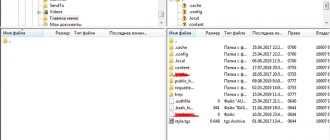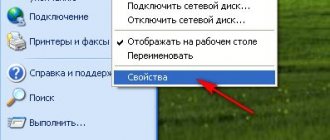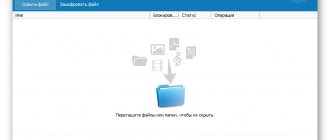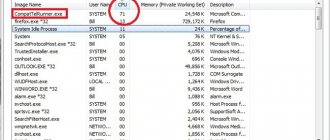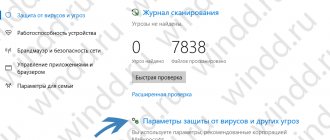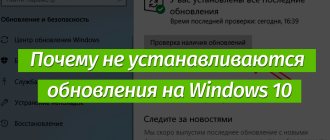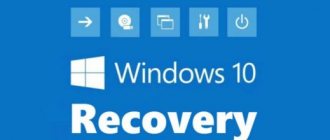" Programs
Evgeny Opanasenko 12/17/2017
The appearance on the computer of various programs, the downloading and installation of which was not initiated by the user, can sometimes go completely unnoticed by the user.
They will only negatively affect the computer in one direction or another.
One such program is MailRuUpdater, and in this article we will talk about what it is and how to remove such software.
So what are these Windows services?
Services
- applications that are automatically or manually launched by the system when Windows starts and perform various tasks regardless of the user’s status.
Open list of services
can be done in several ways:
1. Hold down the windows button and press R, a window will open, enter services.msc there
2. Start > Control Panel > Administrative Tools > Services
3. Start > right-click on my computer > Manage > Services and Applications > Services
As you can see, there are quite a lot of them in Windows and by downloading, you can find out what services exist and what each of them is responsible for
.
Since services are applications, they operate and use some of the computer's resources. you can improve its performance. Let's see what can be disabled.
What services can be disabled in Windows 7, 8
I did not make a list of those services that can be disabled, because... many services are individual. I just tried to describe each service and in what situations they can be disabled. If you need to turn something off mindlessly, then just use .
* BranchCache
The service caches network content. If you don't use your home network, you can turn it off altogether.
* DHCP client -
If you use the Internet, do not touch it under any circumstances. It is this service that assigns you an IP address.
* DNS client
-
Also a necessary service for using the Internet. Works with your DNS (serves in the right directions).
* KtmRm for distributed transaction coordinator -
system transaction function. We leave it the same way.
* Microsoft .NET Framework -
We leave all such services as is. They serve for the normal operation of most applications.
* Parental Controls -
Parental control service. If you don't use it, you can turn it off.
* Plug-and-Play
serves for automatic recognition of changes in the system. For example, when you connect a flash drive, this service wakes up... So we leave it as it is.
* Quality Windows Audio Video Experience -
transmission of audio and video over the network in real time. It is not needed only if there is no network (or Internet), in other cases we leave it.
* Remote Desktop Configuration -
For remote desktop. If you do not use remote connections, disable it.
* Superfetch
Useful feature, works with cache. Speeds up Windows, so leave it.
* Windows Audio -
Controls sound. If you don't need the sound, turn off the sound. In other cases we leave it.
* Windows CardSpace -
unnecessary and unsafe service. That's why we turn it off.
* Windows Driver Foundation - User-mode Driver Framework -
For normal operation of the drivers, do not touch. Let it remain as it is.
* Windows Search -
Indexing files for search. If you don’t use it and have time to wait until the file is found, then disable it. Be sure to disable it on the ssd!
* WMI Performance Adapter -
needed for services that require wmi, install manually. If any applications need them, they will launch them themselves)
* WWAN auto-configuration -
service for using mobile Internet. If you use a usb modem or SIM card in your laptop, do not disconnect it.
* Offline files -
helps you work autonomously with inaccessible files that were downloaded before. We set it manually.
* Network Access Protection Agent -
We set it manually, because... if necessary, the service will start if some program requests the necessary information.
* And
the IPsec policy agent
is needed if you have a network and the Internet.
* Adaptive Brightness Control -
Leave it if there is a light sensor.
* Windows Backup -
If you don't use it, turn it off. But it’s better to read about archiving in Windows, you never know, you’ll use it.
* Windows Biometric Service -
needed only when using biometric devices. In other cases we disable it.
* Windows Firewall -
To be honest, I always turn it off, because... I have nothing to steal) And if they encrypt the data, I will restore it) But I advise you to get, for example, Kaspersky Internet Security, which has both an antivirus and a firewall. And turn this one off, because... it sometimes blocks things that are not needed) In general, it monitors the security of your computer and closes ports so that thieves cannot get into your computer)
* Computer browser
-
No need for home network. Manually.
* Web client -
It's boring if you don't have internet. Used to work with files on the Internet. We leave it.
* Virtual disk -
Service for working with storage devices. We set it manually.
* IP Ancillary Service -
Works with protocol version 6. I always disable it itself, so the service can be disabled altogether.
* Secondary login -
Set it manually, because... some games or programs will enable it if necessary.
* Grouping of network participants -
Needed for home group. Install manually, you never know...
* Disk Defragmenter -
In principle, it does not interfere. You can leave it or turn it off. If you turn it off, I recommend doing it once a month. And for ssd drives, we disable it altogether!
* Automatic Remote Access Connection Manager -
We set it manually. Needed for remote connections.
* Print Manager -
Needed if you have something to print from. In other cases we disable it.
* Remote Access Connection Manager -
manually. Once I disconnected it completely and could not create a connection. So it's better to do it manually.
* Desktop Window Manager Session Manager −
If you don’t use transparency from Aero, you can turn it off, it will give a big boost.
* Network Member Identity Manager −
It's better to set it manually.
* Credential Manager -
Better by hand. Stores your data, such as logins and passwords.
* Security Account Manager -
It's better to leave it as is. If you disable this service, all changes to the local security policy will be lost.
* Access to HID devices -
Access to shortcut keys. Disable it, if some combinations stop working, then put it back.
* Windows Event Log -
records all events. A useful tool for the experienced user. It is impossible to disable.
* Performance Logs and Alerts -
system service, leave it as is.
* Software Protection -
Also a system service, leave it as is.
* Windows Defender -
Protection against spyware and malware. Install a normal antivirus and disable this service.
* CNG Key Isolation -
Manually.
* Windows Management Instrumentation -
System service, without it, some applications may not work correctly, so it’s better to leave it.
* Application Compatibility Information -
A useful thing, it helps launch applications that refuse to run on your OS. We set it manually.
* Group Policy Client -
We leave it. Responsible for security policy settings.
* Changed Link Tracking Client -
Tracking ntfs files is not necessary. Turn it off.
* Distributed Transaction Coordinator -
We set it manually.
* Windows Presentation Foundation font cache -
We set it manually. Applications will launch it if necessary.
* SNMP Trap -
Some programs will collect information about you. So turn it off.
* Remote Procedure Call (RPC) Locator -
Manually, if necessary, applications will launch it.
* Routing and remote access -
Need not. Turn it off.
* IPsec Key Modules for Internet Key Exchange and Authenticated IP -
Not necessary, but better to do it manually.
* DCOM server process launcher module -
System service, leave it as is.
* NetBIOS support module over TCP/IP -
If there are no other computers on the network, then manually.
* Windows Instant Connections - Setup Logger -
Manually.
* SSDP Discovery -
Leave it as is. Required for new devices.
* Interactive Service Discovery −
Manually.
* Internet Connection Sharing (ICS) -
Not needed if you do not share your Internet over network connections.
* Shell Hardware Definition −
necessary for the autorun dialog box of a disk or flash drive. Whatever suits you, most people need it. I left.
* Basic TPM services −
Only needed to use TMP and/or BitLocker chips.
* Remote Desktop Services User Mode Port Redirector -
If you don't use remote connections, then you don't need it. It's better to install it manually.
*
IP bus enumerator PnP-X -
It is better to install it manually.
* Nutrition -
Doesn't turn off. We leave it.
* Task Scheduler -
It is advisable to leave it as is, because... Nowadays many programs use it.
* Media Class Scheduler −
We leave it to those for whom sound is important.
* Support for the "Problem and Resolution Reports" control panel item -
Manually.
* Smart Card Removal Policy -
For smart card users, it is better to do it manually.
* HomeGroup Provider -
To use home groups. Better by hand.
* Wired Auto-Tuning -
Manually.
* Software Shadow Copy Provider (Microsoft) -
Manually.
* Homegroup Listener -
Manually.
* PNRP protocol -
We also leave it manually. Some applications may use the service.
* Publishing Feature Discovery Resources −
Needed if you want to show your files to other computers over the network. If you don't want to, then manually or disable it.
* Work station -
It's better to leave it, because... Some applications use this service.
* Certificate Distribution −
Better by hand.
* Extensible Authentication Protocol (EAP) -
Manually.
* Windows Event Collector -
Manually.
* Application Details -
Manually.
* Server -
If the computer is not used as a server or does not share access to files and printers, then turn it off.
* Thread Ordering Server -
Disable if there is no home group.
* Network Login -
Manually.
* Network connections -
Leave it as is. If there is no network or Internet, you can turn it off.
* COM+ Event System -
set manually. Applications that depend on this service will launch it themselves if necessary.
* COM+ System Application -
Also manually.
* SSTP Service -
We leave it as is, the service is needed if there is Internet on the computer.
* WinHTTP Web Proxy Automatic Discovery Service -
If you need internet, then leave it as is.
* WLAN AutoConfig Service -
service for wireless networks. Accordingly, if they are not there, it is not needed.
* Basic Filtering Service -
on the one hand, it is not needed (if security is not needed), but on the other hand, some programs may produce errors. So we leave it.
* Tablet PC Input Service -
If the screen is not touch-sensitive, then it is not needed.
* Windows Time Service -
needed to synchronize time with the Internet.
* Windows Image Upload Service (WIA) -
The service is only needed if there is a scanner. She is responsible for receiving images from scanners and cameras.
* Microsoft iSCSI Initiator Service -
We install it manually, if programs need it, they will launch it themselves.
* Network Saving Interface Service -
Needed for normal network operation.
* Windows Font Cache Service -
serves to improve performance, caches fonts and does not waste time loading.
* With
the Media Center set-top box service -
If you don't use any set-top boxes, you don't need it.
* Block Level Archiving Engine Service -
We set it manually. If archiving or restoration is needed, the service will start on its own.
* Net.Tcp Port Sharing Service -
Off by default. Only needed if you need the Net.Tcp protocol.
* Windows Media Player Network Sharing Service -
Manually. If you need it, it will turn on.
* Portable Device Enumerator Service -
Used to synchronize music, videos, etc. with removable media. I would install it manually. This is not always necessary.
* Windows Media Center Scheduler Service -
Needed if you only watch programs in Windows Media Player.
* Bluetooth Support -
Needed if you have Bluetooth.
* Diagnostic Policy Service -
Needed to diagnose problems... To be honest, it rarely helps. Therefore, you can experiment by turning it off. If necessary, turn it on.
* Program Compatibility Assistant Service -
The service is needed to run programs that are incompatible with your OS. If there are none, install them manually.
* User Profile Service -
Better to leave it. It works with computer user profiles.
* PNRP Computer Name Publishing Service -
Needed for home groups.
* Windows Error Logging Service -
Logs errors. It's better to install it manually.
* Windows Media Center Receiver Service -
to watch TV and radio programs in the player.
* Connected Network Information Service -
It is better to leave it as is for normal network operation.
* Network List Service -
It's better to leave it that way.
* SPP Notification Service -
For licensing. Leave by hand.
* System Event Notification Service -
If you are not going to watch Windows messages, then you do not need it.
* Windows Remote Management Service (WS-Management) -
Place it manually.
* BitLocker Drive Encryption Service -
Encrypts disks. If you don't use it, it's better to turn it off.
* Application Layer Gateway Service −
The service is needed only to work with the firewall. Manually.
* Cryptography Services -
To install new programs, it is better to leave it as is.
* Remote Desktop Services -
If you do not use remote desktops, then disable it.
* Smart card -
If you don't use them, then you don't need it.
* RPC Endpoint Mapper -
The service is needed for incoming traffic. Nothing can be done about it. That's why we leave it.
* Windows Audio Endpoint Builder -
If you need sound, leave it.
* Telephony -
Leave by hand. It will start if needed.
* Themes -
They eat up a lot of memory resources. If you don't need it, turn it off.
* Volume Shadow Copy -
Creates recovery points, backing up in the background. Place it manually. It will start if necessary.
* Link layer topologist -
Also by hand. It will start if needed.
* Remote Procedure Call (RPC) -
System service. Leave it as is.
* Remote registry -
Allows remote users to manipulate your registry. Turn it off.
* Application Identity -
Manually.
* Diagnostic system unit -
Diagnosis of problems. Place it manually.
* Diagnostic Service Node -
Also manually.
* Generic PNP Device Node -
Place it manually. Not all devices are PnP.
* Application Management -
Place it manually. The service allows you to configure policies for applications.
* Manage certificates and health key -
Install it manually, if you need it, it will start on its own.
* ActiveX Installer -
Also manually. You will need to install such an object, it will start on its own.
* Windows Installer -
Installation of programs.msi. Manually.
* Windows Modules Installer -
Installs and removes components and updates. Manually.
* Fax -
Needed if you have a fax.
* Background Intelligent Transfer Service (BITS) -
Leave it by hand. The service is useful.
* Discovery Provider Host -
Leave it by hand. It will need to start.
* Windows Color System (WCS) -
Manually. The devices will need it and they will launch it.
* Security Center -
Monitors Windows security. She annoys me with her notifications. So whether to turn it off or not is up to you.
* Windows Update -
On the one hand, a useful function. It closes holes in the system, updates drivers, but on the other hand, it actively uses the Internet, memory resources, and if you turn off the computer during the update, the OS may crash. So you also have to choose what is more important, security or performance.
* Encrypting File System (EFS) -
For file security. It's better to leave it as is manually.
I tried to present the entire list of services. By disabling some, you will improve the performance of your computer. You can also decide at your own discretion which ones are needed and which ones are not. For example, if there is no Internet, then you can safely cut half of it; if there is no printer, then you can also turn off a lot. Thus, depending on your needs, you can significantly invigorate your old computer.
Mailruupdater.exe is a module that updates Mail.ru software. In particular, the Amigo browser, the Guard anti-virus utility, Mail.ru Sputnik. Has the signature of the developer, belongs to the category of trusted applications. But it tends to cause software conflicts, automatically downloads application updates without the user’s knowledge, slows down the loading of pages in the browser and the functioning of the system as a whole.
To remove the mailru updater component from your computer, follow the instructions below:
1. Press - “Ctrl” + “Shift” + “Esc”.
2. In the Manager window that appears, in the “Processes” subsection, right-click on the MailRuUpdater.exe element.
3. In the context menu that pops up, click “End process”. Close the Manager window.
4. Press - “Win + R”.
5. Enter the directive - msconfig - in the "Open" line.
6. In the “System Configuration” settings panel, in the “Startup” section, uncheck the boxes next to the MailRuUpdater and Mail.Ru Update Service elements.
Attention! Only one of these elements can be specified in the startup list.
7. Click “Apply” and “OK”. Close the window.
8. Go to: Start → Control Panel → Uninstall a program.
9. Right-click on the “Automatic Software Updates” application in the directory.
10. Left-click the “Delete/Change” panel that appears.
11. If necessary, confirm the uninstallation of the module.
The Mail.ru updater can also be neutralized from the operating system using the Revo Uninstaller Pro uninstaller utility:
1. In Revo Uninstaller, left-click to select the “Automatic Service...” module.
2. Click the "Delete" option.
3. Confirm the uninstallation: click “Yes”.
4. Select an algorithm. Click Search.
5. In the “Found registry keys” panel, click “Delete” to remove the remaining updater keys. Click “Next” again.
As you know, many users, when installing certain programs, are not only very annoyed, but also infuriated by the appearance of some unnecessary panels or additional services. And Mail.Ru services are no exception in this regard. There are several components like Sputnik Mail.Ru or the MailRuUpdater.exe service. We will now look at how to remove the “updater”, as well as other components. There are several ways to do this.
What kind of service is MailRuUpdater.exe (Mail.Ru Updater)?
In order to understand what kind of service this is, just look at the translation. The word “Updater” itself means an update service. In this case, this applies to absolutely all software products of the Mail.Ru service installed on the local computer.
What’s saddest is that in the list of processes that are automatically launched at system startup and running in you can also find the MailRuUpdater.exe service. Not everyone knows how to remove it, especially since when using standard tools, only the tip of the iceberg is removed, so to speak, after which a heap of garbage remains in the system, which an inexperienced user cannot find on his own. And some components are not removed at all. Let's see what can be done in such a situation.
What it is?
In previous articles we talked about such a program as the Mail.ru Automatic Software Update Service. So Mailruupdater in autoload is what it is. The simply executable .exe file is named shorter and in English.
Mailruupdater.exe *32 in running processes
It can be found in the Task Manager on the Processes tab. It is called MailRuUpdater.exe *32. If you find it in your system, then this icon will be displayed in the system tray near the clock:
System tray icon near the clock
The main task of MailRuUpdater is to install the start page in browsers, install various extensions, as well as programs from the Mail.ru company.
To put it simply, nothing useful. And its constant autostart along with the OS only slows it down.
MailRuUpdater.exe: how to remove it in the simplest way?
Let's start with the simplest method, which involves using standard tools of the operating system itself (in this case we are considering exclusively Windows).
First, we need to stop the MailRuUpdater.exe service in the directory of active background processes present in the Task Manager. Removal will occur a little later. To stop the service, you can use the simplest emergency termination of the process in the form of a task cancel button. Please note that in Windows 10 all currently active and background processes are displayed; in lower versions you will have to use the services window.
Now you need to disable the service so that it does not start when Windows boots. To do this, call the “Run” menu and use the universal command for all occasions - msconfig. On the tab displaying startup items, simply uncheck the corresponding service. After this, some versions of Windows will require a reboot.
After a reboot, sometimes a message like “MailRuUpdater.exe: application error” may appear. Not always, but maybe. It's OK. Now we use the standard “Control Panel” with the Programs and Features section and remove the service in the usual way. This is what most users advise, who simply do not know how much garbage remains after removal, and some components are not removed at all and still hang in the background. Therefore, it is strongly recommended to perform all actions when booting the system in safe mode (and it is not a fact that everything will be deleted), and the message “MailRuUpdater.exe: application error” will appear again and again even when accessing other software products. Now let's see what needs to be done additionally.
Disable system notifications
After these steps, the system will not search for updates and install them automatically. But that is not all. Since this is a negative event for Windows 7, it will still remind you of this with a flag with a red cross in the right corner of the monitor.
Let’s turn off this reminder of the changes made:
- If you left-click on the checkbox, a context menu will pop up where we need the “ Open support center ” item.
- In the window that opens, we are interested in the line in the left panel “ Support Center Settings ”. Click on it.
- In the window that appears, uncheck all the checkboxes and confirm your actions with the OK button.
Now the red cross has disappeared and the operating system does not display any reminders.
But nothing prevents you from updating manually if you want. All you have to do is start searching for Windows 7 updates again.
Cleaning the registry
As a rule, garbage after uninstallation remains in the form of undeletable files and folders (which will be discussed a little later) and residual entries in the system registry. Searching for them manually is a thankless task.
For this, it is best to use automatic cleaners. One of the most powerful is the CCleaner application. Simply launch the program and use either one-click optimization or select the appropriate module responsible for the system registry. After this, there will certainly be no components left in the background.
Using specialized uninstallation utilities
In general, if you understand the MailRuUpdater.exe service and how to remove it entirely, it is best to turn to specialized programs. As one of the most powerful utilities, we can recommend iObit Uninstaller (today we already have the latest version 5.1).
When uninstalling programs of this type, the application first uses the “native” uninstaller of the component being removed or a standard Windows service (Unwise, Uninstall Shield, etc.), and then performs a full scan of the computer, including the hard drive and system registry, for the presence of residual garbage ( leftovers), after which, upon receiving confirmation from the user, it deletes absolutely everything.
By the way, it is advisable to use this utility in the case when the Mail.Ru update service is not displayed in the list of programs for some reason. Here you can use search and forced uninstall. To be completely sure, you can use CCleaner after the uninstallation process is complete (although in most cases this is not necessary).
If not everything is deleted...
Finally, it remains to see if everything has been deleted. We've sorted out the registry. As for residual files, you can do the following.
In the main Start menu, we use the search line, in which you should enter C:\Users\"Username"\AppData\Local\, and then find the folder or files called Mail.Ru, and then delete them. Now, after all the actions taken, you can be sure that this intrusive service and all its components will be completely removed. Again, the folder or files may not be able to be deleted. To fix the problem, you need to log in as an administrator or use safe mode (this, by the way, applies to all the above actions).
Many users are faced with the fact that once in the Control Panel
and seeing the number of installed programs, they are simply lost. The reason for this is a lack of understanding of how to manage all this and why it is even needed.
Moreover, when familiarizing yourself with the purpose of the programs, it turns out that many of these programs are not needed at all and only take up space on the hard drive and slow down the computer.
Let's look at the Mail Ru Automatic Program Update Service. This program is one of the programs that are installed automatically. That is, usually the user does not install it specifically,
and sometimes he doesn’t even know that he confirmed the installation of this service.
How does this happen?
- The user installs a program from the Internet, and other files are installed along with it. In most cases, the user does not even read the list of accompanying programs and does not uncheck the box to install them. Thus, a lot of unnecessary services end up on the computer, which, in fact, are not needed, and sometimes slow down the operation of the device.
- The program may end up on the device as an accompanying file, but its installation cannot be prohibited. That is, you can only delete it from the Control Panel.
- The file is downloaded from unsafe resources. Along with the downloaded file, various virus programs are downloaded to the computer and then installed.
The Mail Ru automatic software update service is not malware,
however, it essentially does not provide any practical benefit.
The main task of this service is to install the start page in browsers, install various extensions and various programs created by Mail Ru.
Some time ago, the well-known Amigo browser
, which not only installed itself, but was also accompanied by a package of additional programs, one of which was the automatic update service.
This service updates all programs from Mail Ru automatically.
That is, the user does not perform any actions for this; the program performs everything independently. Sometimes, the owner of the device does not even notice what is happening; the only visible change is the reduction of space on the computer’s hard drive.
There is a misconception that this service is a virus program. It is not true. The program is not capable of causing any damage to the user’s device and files. But there is no particular benefit from it either, so it is better to remove this program.
